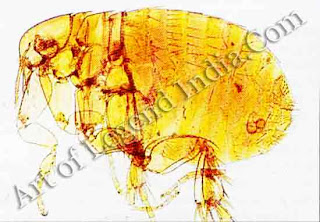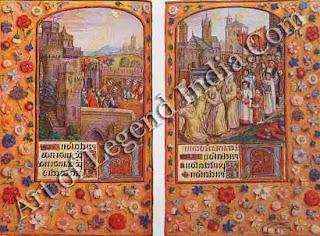The Plague
One of
the most feared diseases of Grunewald's lifetime, the plague swept relentlessly
through Europe in repeated epidemics, helped by mistaken medical theory and
ineffectual remedies.
In the
foreground of Grunewald's Temptation of St Anthony lies a helpless, diseased
figure, covered with sores. This panel forms a part of The Isenheim Altarpiece,
which was painted for the church of the brothers of St Anthony, who devoted
themselves to nursing the sick. The altarpiece offered comfort and hope to the
inmates of the Isenheim hospice, many of whom were dying of syphilis and the
plague.
DIVINE RETRIBUTION
Outbreaks
of the plague occurred frequently from the mid-14th to the mid-17th century,
often reaching epidemic proportions. Plague was explained by the Church as a
divine punishment for sin, to be countered by prayer, fasting, confession,
religious processions and the rejection of vain pleasures such as dancing and
cards. Images of the dance of death, which appear in church art and in popular
woodcuts, were an early artistic response to the deadly epidemics which began
with the 'Black Death' of the 14th century.
Religious
art of the time often depicted an angry God shooting arrow of plague at the
sinful. The ancient Greeks had prayed to Apollo, the archer-god whose arrows
brought pestilence, to spare them; Christians prayed to St Sebastian, martyred
by arrows, for protection from the plague. He too appears as a figure on The
Isenheim Altarpiece.
Medical
writers sought natural explanations for the plague, but could not agree on
either the cause or the treatment. The European plague, or pestilence, of Grunewald's
day was bubonic plague, which we now believe to be transmitted to man by the
fleas of plague-infected rats. In its most deadly, pneumonic, form, it was
spread, like the common cold, by droplets sneezed out by one victim and inhaled
by another. The children's singing game Ring a Ring of Roses is supposed to
contain a reference to these fatal sneezes in the line: 'Atishoo, atishoo, we
all fall down'.

In the
15th and 16th centuries, doctors explained the cause of plague according to the
teachings of Hippocrates, who believed that outbreaks were due to a local
corruption of the air. This, in turn, was thought to infect the inhabitants,
contaminating the bodily fluids or 'humours' which determined a person's
temperament and causing disease and death. This corrupt or 'putrid' air might
be the result of unusually warm and humid weather, or of a particular
conjunction of the stars, which transmitted their malign effects to earth
through the air.
Because
of the analogy with rotting and putrefaction, the cause of plague was
associated also with unpleasant smells, including the vapours arising from
volcanoes, burial grounds and even dunghills. Some theories suggested that the
air was not merely corrupted but actually poisoned: an explanation which,
doctors argued, explained the fact that it might attack at any time of the year
not just in hot, damp weather and struck with the speed and deadly effect of a
poison.
Plague
was usually classed by doctors as a fever, the effect of which was to upset the
balance of the four humours blood, phlegm, choler and black bile resulting in
an excess of hot and moist qualities. Those who suggested that plague, like the
newly identified disease of syphilis, acted in the manner of a poison, claimed
that it attacked the 'total substance' of the body directly, and was far more
virulent than the 'qualitative' diseases.
Whatever
the proposed cause, methods of medical treatment were almost entirely
ineffective. The most practical was the advice to avoid breathing the 'deadly
air' by leaving plague-stricken cities. Those who could afford to leave did so,
often in defiance of quarantine regulations designed to prevent the spread of
disease.
Much of
the medical treatment aimed to drive the plague poison out of the body, by
sweating, purging, inducing vomiting and blood-letting. The buboes or swellings
which characterized the disease were lanced, and blisters were raised and then
opened to draw out the pus. Other drug remedies treated the symptoms of the
disease, such as thirst and sleeplessness.
MIRACLE CURES

Because
of the suggestion that plague acted in the same way as a poison, antidotes,
such as the famous mithridatum and theriac or 'Venice trcacle', were popular
ingredients in plague remedies. Town physicians and academics wrote treatises
on the proper treatment of the disease, containing their favourite recipes. New
chemical remedies were introduced by followers of the German physician and
alchemist Theophrastus Paracelsus. Quacks made the most of the opportunity,
selling 'cures' to the desperate, who had often been abandoned by qualified
doctors who put survival above their professional duties. People also attempted
to counter the plague by fighting the unpleasant smells associated with its
cause. They burned fires with sulphur and other chemicals, wore or carried
nosegays (pomanders filled with aromatic herbs and spices or vinaigrettes) and,
from the 16th century onwards, even tried to ward off the disease by smoking
tobacco plague-pits are often identified by the clay pipes of the gravediggers.
PREVENTIVE MEASURES
Doctors
rarely noted the contagious nature of the disease, which did not fit in with
the Hippocratic theory of miasma or unhealthy air. An attempt to prevent dung
heaps and rotting garbage from corrupting the air led in some cases to orders
for improved street cleaning and public hygiene, which would have had an
indirect effect on public health. City governments and public health officials,
however, clearly recognized that plague was spread by the movement of
travellers and goods, and Italian cities in particular developed elaborate
quarantine procedures, isolating recent arrivals and imported goods in
lazarettos outside the city, which were also used as isolation hospitals in
time of plague.
British
and German towns had fewer lazarettos, though Nuremberg had a newly built one
at the time of an attack of plague in 1562, and London acquired its first
pest-house at the end of the century. In major epidemics only a fraction of the
sick could be accommodated, and in London the city government passed harsh legislation
forbidding anyone to leave a house where a case of plague had been found. Doors
of infected houses were marked with a cross to warn passers-by. Contact with
the sick or with the bodies of plague victims was supposed to be confined to
the government plague-spotters or 'searchers' who reported new cases, and to
the gravediggers who toured the streets at night with carts for the dead, and
buried them in mass graves outside the city.

Despite
all the precautions and remedies, the death toll in major epidemics was
apallingly high. A Nuremberg doctor reported some 8600 deaths from plague in
the city in one year, 1494. At its height, the London Great Plague of the 17th
century claimed over 7000 victims a week and the bills of mortality on which
this figure is based may represent only half the real total.
Plague
was not the only epidemic disease of Grunewald's day smallpox, the sweating
sickness, and syphilis also claimed many victims. But it was one of the most
spectacular, marking victims with swellings and carbuncles, and sometimes with
red, black or blue spots. The man in The Temptation of St Anthony may, indeed,
be a plague victim a detail which adds to the nightmarish quality of the scene.
Believing the plague to be 'God's Scourge', victims in Grunewald's day suffered
from a form of supernatural torment which matched that of the saint himself.
Writer
– Marshall Cavendish




0 Response to "German Great Artist Mathis Grunewald - The Plague"
Post a Comment